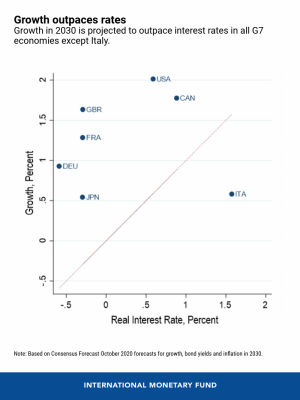Marcos Chamon is a Deputy Division Chief within the Debt Policy Division of the Strategy and Policy Review Department of the International Monetary Fund (IMF). Jonathan D. Ostry is Deputy Director of the Asia and Pacific Department on the IMF and a Research Fellow on the Center for Economic Policy Research.
______
Many nations are experiencing a mix of excessive public debt and low-interest charges. This was already the case in superior economies even previous to the pandemic however has turn out to be even starker in its aftermath. A rising variety of rising market and growing economies are likewise having fun with a interval of adverse actual charges—the rate of interest minus inflation—on authorities debt. The IMF has known as on nations to spend as a lot as they will to guard the susceptible and restrict long-lasting damage to economies, stressing the necessity for spending to be well-targeted. This is very essential in rising market and growing economies, which face tighter constraints and related fiscal dangers, the place better prioritization of spending is of the essence.
But what ought to finally be performed in regards to the excessive ranges of public debt within the aftermath of this disaster? In an earlier paper we confirmed that, offered fiscal area stays ample, nations mustn’t run bigger price range surpluses to carry down the debt, however ought to as a substitute enable development to carry down debt-to-GDP ratios organically. More not too long ago, the IMF has harassed the necessity to rethink fiscal anchors—guidelines and frameworks—to take account of traditionally low rates of interest. Some have urged that borrowing prices—even when they transfer up—will achieve this solely regularly, leaving time to contend with any fallout.
Two points appear salient. First, will borrowing stay low-cost for the total horizon related for fiscal planning? Since that horizon appears to be the indefinite future, our reply right here can be “no.” While some have argued that completely adverse growth-adjusted rates of interest is likely to be an affordable baseline, we’d spotlight the dangers round such a benign future. History provides quite a few episodes of abrupt upticks in borrowing prices as soon as market expectations shift. This threat is very related for rising market and growing economies the place debt ratios are already excessive. At some level, money owed might properly must be rolled over at larger charges. Limits to how a lot could be borrowed haven’t disappeared, and the necessity to keep properly away from them is even sharper in a world the place rates of interest and development are uncertain.
Second, will it suffice to reply regularly to larger rates of interest? Our reply once more is “no.” Theory and historical past recommend that, when buyers start to fret that fiscal space might run out, they penalize nations quickly. Market-driven changes aren’t essentially gradual, nor do markets solely ratchet up the price of borrowing as soon as wholesome development returns—certainly, simply the alternative appears believable.
There are deeply engrained market expectations of adverse interest-growth differentials (the place actual rates of interest are lower than development charges) for many superior economies. While long-term charges within the United States have been rising for the previous a number of months, they continue to be low even by post-2008 requirements. The chart beneath compares the Consensus Forecast for development within the G7 economies with the actual rate of interest (10-year bond yield minus inflation) in 2030. The forecasts indicate development charges properly in extra of actual rates of interest for all G7 nations besides Italy.

But on the flipside, debt is getting nearer to ranges that had been beforehand thought-about harmful. Earlier we estimated debt limits past which the fiscal stability wouldn’t be capable to regulate to market-driven will increase in threat premia. These model-based estimates, constructed on a strategy later adopted by ranking businesses in their very own forecasts, replicate market circumstances after the Global Financial Crisis however previous to COVID-19. Nevertheless, they’re nonetheless informative by conveying what was perceived to be the debt restrict as of a decade in the past. This gives a sign of what might be anticipated if these earlier circumstances resurfaced. The bar chart exhibits how a lot of the estimated fiscal area (debt restrict minus 2007 debt) was used from 2007 to 2019 (blue bars), and the way a lot is projected for use from 2019 to 2025 (orange bars). For some nations, the remaining fiscal area wouldn’t enable a response of a dimension akin to what was deployed following the Global Financial Crisis or COVID-19—probably constraining motion within the occasion of one other main shock.

At the danger of over-simplifying, we will contemplate three different views:
- Interest charges stay low in superior economies even when debt continues to extend. In such a case, there isn’t any want to fret about debt or regular (non-accelerating) deficits. The debt ratio would proceed to rise however will finally stabilize at the next stage.
- Interest charges are low at given debt ranges, however they’d not stay low if debt had been to rise considerably. Most G7 nations can run a main deficit near 2 p.c of GDP whereas nonetheless stabilizing their debt ratios. In this state of affairs, they do take pleasure in a free lunch offered deficits stay beneath the debt (ratio)-stabilizing stage.
- Interest charges are low however might regulate, maybe abruptly. In this state of affairs, there’s a case for profiting from favorable circumstances to cut back debt and rebuild buffers. Even if the perceived threat is small, the massive prices related with compelled adjustment might justify worrying about excessive debt and planning already for a riskier future.
What’s the ethical of the story? It is certainly self-defeating to focus on the next budgetary stability when the pandemic shouldn’t be behind us. But that doesn’t imply we must always not fear in regards to the penalties for debt paths, not least as a result of markets might finally fear, even when low borrowing prices now recommend these worries are far-off. A prudent baseline is that borrowing prices would possibly turn out to be considerably larger, especially for rising markets and growing economies. Then the duty is to find out the fiscal coverage wanted to anchor expectations for a riskier future. Advanced economies with ample area might not want to fret a lot, however these with very excessive debt—the place the explanations for low borrowing prices are imperfectly understood—would possibly must take some anchoring insurance coverage. Emerging market and growing economies are prone to face extra binding fiscal constraints and may have to regulate sooner (however once more, not earlier than the restoration is firmed up). All nations might want to anchor fiscal plans with some notion of sustainability, which might additionally attenuate the priority of a market repricing of threat. This shouldn’t be tomorrow’s fear if fiscal area is unsure and market expectations can flip abruptly. Laying out plans to anchor expectations must be in the present day’s fear for all.
____
This article has been republished from blogs.imf.org.
____
Learn extra:
– A Debt-Fuelled Economic Crisis & Bitcoin: What to Expect?
– US Dollar Share of Global Foreign Exchange Reserves Drops to 25-Year Low
– Prepare For ‘Uncertain Future of Money’ – US Intelligence Center
– Central Banks Will Need To Rethink Monetary Policies – PayPal CEO
– Bitcoin Is More ‘Public’ Money than Central Bank-Issued Fiat Currencies
– The Great Depression and Money Printers of Today
– IMF Says Higher Rates Might Reduce Appetite for Risk. And Bitcoin?
– Bitcoin Faces Hedge Test Amid Rising Inflation Concerns



